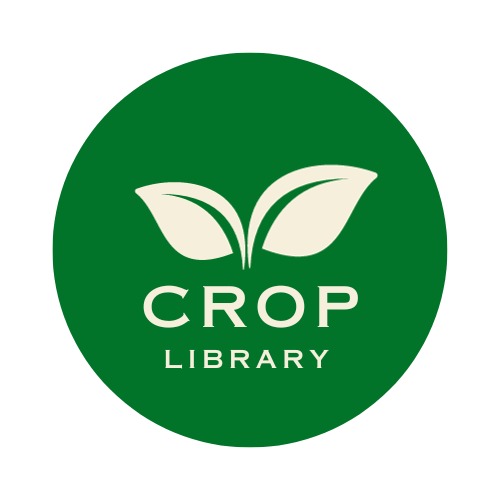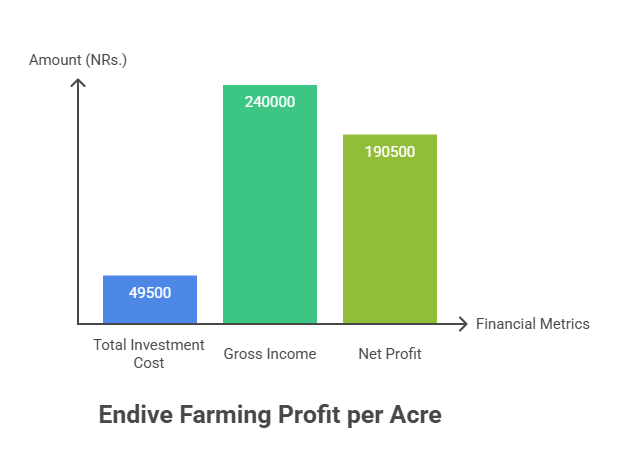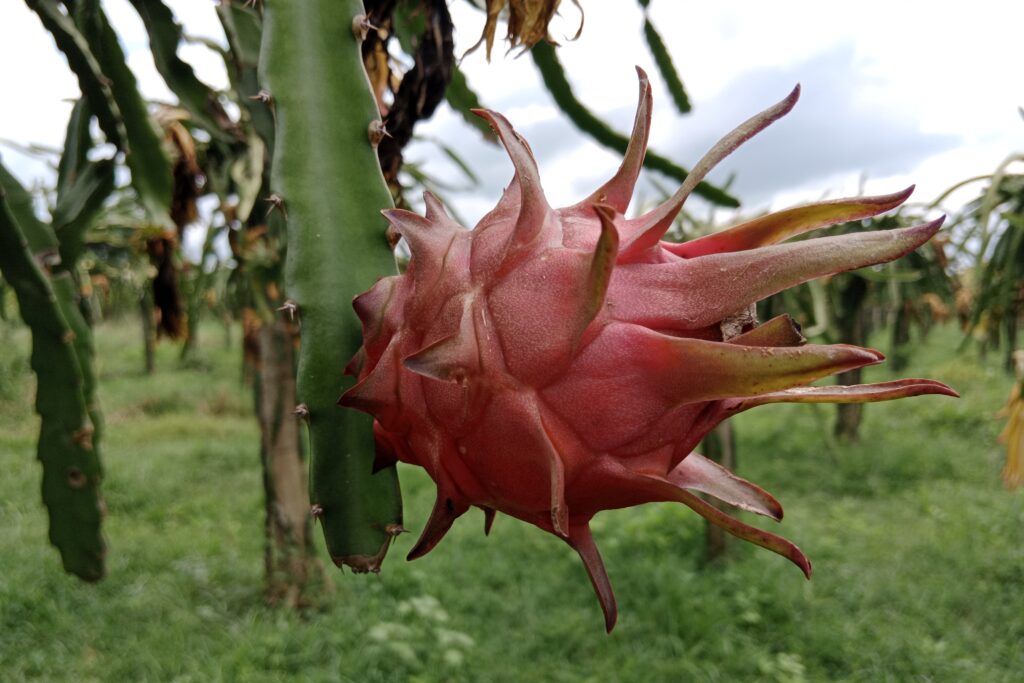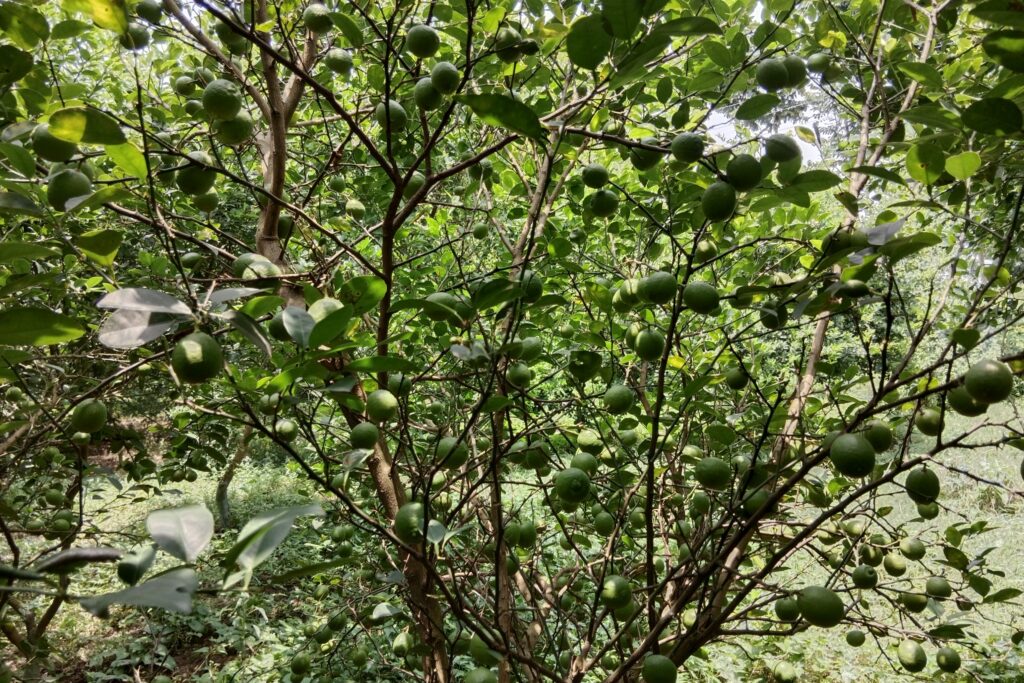Endive Farming
Endive (Cichorium endivia) is a member of the chicory family recognized for its crisp leaves, subtle bitterness, and rich nutritional content. Farmers typically grow two main types: curly endive (frisée), which has finely divided, ruffled foliage, and escarole, known for its broader, smoother leaves.
The crop performs best under cool weather conditions in well-draining soil, with careful attention to planting schedules, irrigation, and pest management.
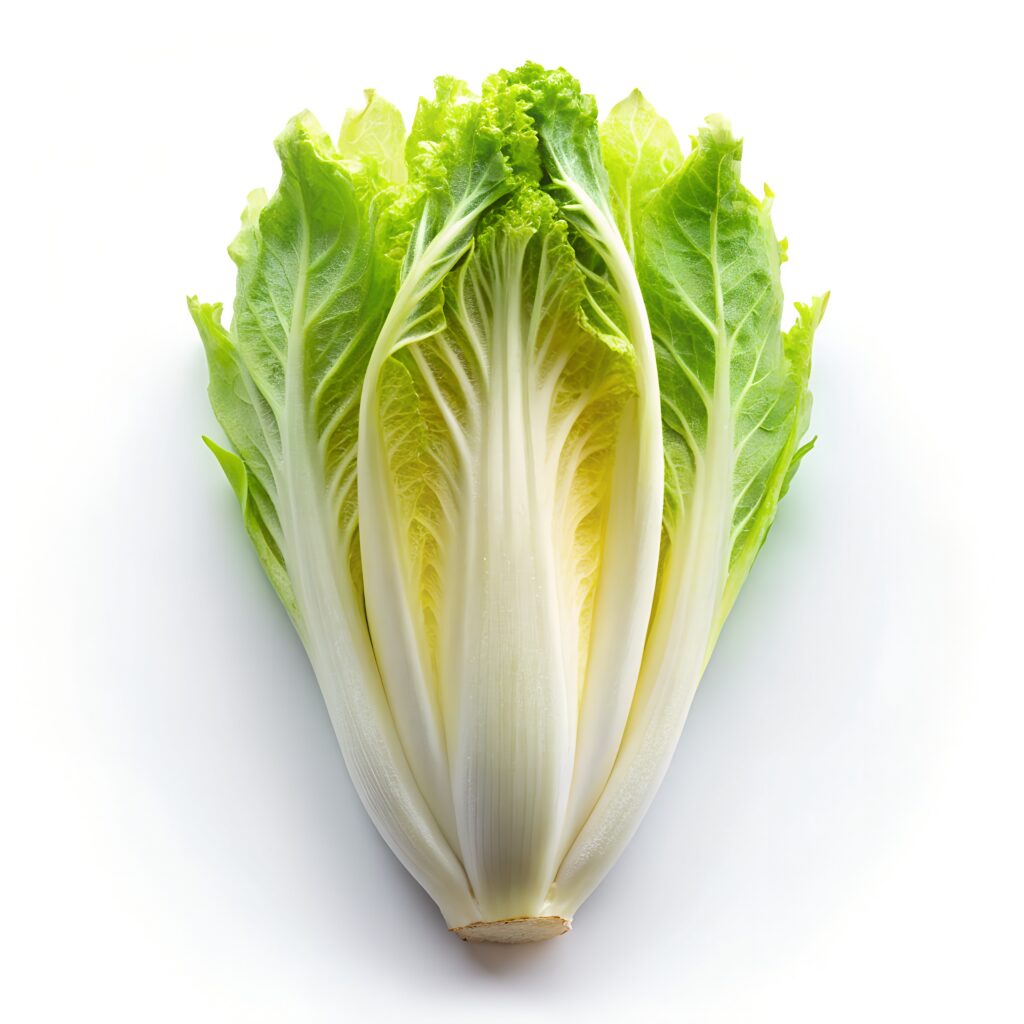
With demand rising among consumers seeking fresh salad greens and healthy dietary options, and with relatively modest production expenses, endive cultivation offers growers a profitable opportunity that can deliver both high productivity and strong financial returns.
Endive farming has emerged as a highly profitable agricultural venture, offering excellent returns for farmers who invest in its cultivation. With a total investment cost of just NRs. 49,500, the crop is capable of generating a substantial income of NRs. 240,000 per acre.
This results in a net profit of NRs. 190,500 after covering all expenses, which clearly highlights the economic potential of this crop.
The impressive profitability is further emphasized by the Return on Investment (ROI), calculated at approximately 385%, meaning that for every rupee invested, the farmer earns around NRs. 3.85 in profit. Such promising figures make Endive farming profit per acre a compelling choice for commercial growers, positioning it as a lucrative and sustainable option in modern agriculture.
Land Preparation
Successful endive cultivation starts with careful soil preparation to create a fine, well-drained seedbed suited for its small seeds. The process generally begins by loosening the soil to about 20–25 cm, which helps reduce compaction and mix in any leftover plant matter.
This is followed by several passes with lighter equipment, such as harrows or discs, to further break down soil clods and improve the tilth. Once the soil is refined, growers shape the ground into flat or raised beds depending on irrigation needs and the natural drainage of the field.
Proper leveling is also important to prevent uneven water distribution or standing water. The end goal is to produce a smooth, clean, and slightly firm surface that allows endive seeds or seedlings to establish well.
Soil Type
Endive performs best in fertile, well-drained loam or sandy loam soils that contain plenty of organic matter. The crop thrives in slightly acidic to neutral conditions, with an optimal pH between 6.0 and 6.8, which provides good moisture retention without causing compaction.
Heavy clay soils are less desirable because they can form a crust that restricts seedling growth and increase the likelihood of root diseases. On the other hand, very sandy soils are also challenging, as they require more frequent watering and nutrient inputs to maintain strong plant development.
Climatic Requirements
Endive is best suited to cool weather, growing most successfully when daytime temperatures remain between 15°C and 20°C. The crop can withstand light frosts, which often improve its taste by reducing bitterness.
However, prolonged exposure to heat above 25°C encourages bolting, resulting in coarse, bitter leaves that have little market value. Because of these requirements, endive is usually planted in spring or autumn, and in areas with mild winters, it can also be produced during the colder months.
Major Cultivars
Cultivars are selected based on leaf type, bitterness, bolt resistance, and season.
| Type / Common Name | Major Cultivars | Key Characteristics |
| Curly Endive (Frisée) | ‘Très Fine Maraîchère’, ‘Natacha’, ‘Galaxy’ | Known for their tight, creamy-yellow hearts. |
| Escarole (Broad-Leaved Endive) | ‘Full Heart Batavian’, ‘Cornet de Bordeaux’, ‘Nuvol’ | Have a broader leaf and a milder flavor compared to curly types. |
Propagation
Endive is almost exclusively propagated by seeds.
Seed Rate per Acre
| Sowing Method | Seed Rate per Acre |
| Direct Seeding | 0.5 to 0.7 kg |
| Transplanting | 0.2 to 0.3 kg |
Nursery Management(For Transplanting Method)
For best results, endive seeds are started in a nursery bed or, more effectively, in seedling trays, as this encourages stronger root growth and reduces the risk of transplant shock.
A sterile, soilless potting medium is recommended to provide a clean, balanced environment for germination. Seeds should be placed only 0.5 to 1 cm deep and the medium kept evenly moist, avoiding excess water that could lead to damping-off. After around 3–4 weeks, once seedlings have produced 4–5 true leaves, they are ready to be transplanted into the main field.
Planting
a). Planting Season
In temperate regions, endive is sown in early spring (March) for a summer harvest or in mid-to-late summer (July to August) for a fall harvest, while in warmer regions it is primarily cultivated as a winter crop to avoid the adverse effects of high temperatures.
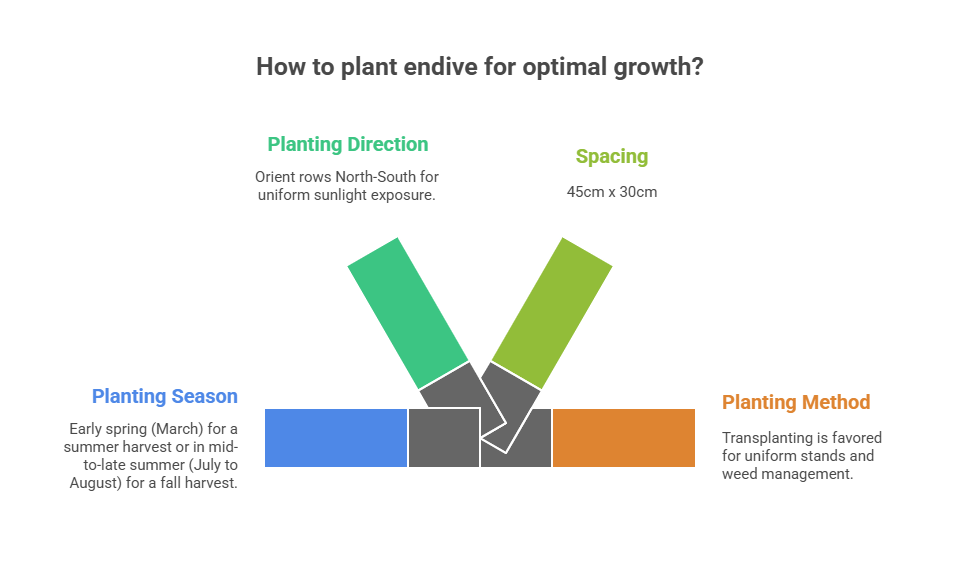
b). Planting Direction
Planting direction is not a critical factor in endive cultivation, though a standard North-South row orientation is generally recommended to ensure uniform sunlight exposure for healthy growth.
c). Spacing
In colder regions or areas prone to waterlogging, endive is often planted on raised beds about 40 cm wide with two rows per bed to reduce risks, maintaining a spacing of 45 cm between rows and 30 cm between plants for optimal growth and air circulation.
d). Planting Method
Endive may be grown either by direct seeding or by transplanting. In direct seeding, the crop is sown thinly in rows—either drilled or broadcast—and later thinned to achieve proper spacing. Transplanting, however, is generally favored because it helps maintain uniform plant stands, reduces seed use, and makes it easier to manage weeds during the early stages of growth.
e). Number of Plants per Acre
With a spacing of 45 cm x 30 cm, an acre can accommodate approximately 29,977 plants.
Irrigation
Water management is a key factor in successful endive production, especially during the head formation stage when steady moisture is needed to avoid bitterness and reduce the risk of bolting.
Drip irrigation is particularly effective, as it conserves water, limits leaf wetness that can encourage disease, and allows nutrients to be delivered directly through fertigation. Irrigation should be light and frequent, with the aim of keeping soil moisture consistent while preventing waterlogging.
Fertilizer and Manure
Nutrient management for endive should ideally follow the results of a soil test. In general practice, about 15–20 tons of well-rotted farmyard manure or compost per acre are incorporated during land preparation, together with 50–60 kg per acre of a balanced NPK fertilizer (such as 10:10:10) as a basal application.
To support leafy growth, a nitrogen-rich fertilizer like Calcium Ammonium Nitrate (CAN) is commonly applied as a top dressing at a rate of 25–30 kg per acre, about 3–4 weeks after transplanting or thinning.
Weed Control
Controlling weeds during the early growth stages of a crop is especially important, since young plants grow slowly and are easily outcompeted. An effective management plan often combines different methods: light cultivation, such as hoeing between rows, can be paired with precise hand weeding within the crop line. Applying organic mulches, including straw or grass clippings, further strengthens this approach by reducing weed pressure while also helping the soil retain moisture.
Interculture Operation
For endive cultivation, techniques such as pruning or training are not generally required; instead, the main care practice is blanching. This procedure, usually carried out one to two weeks before harvest, consists of gathering and securing the outer leaves over the head to exclude light. Doing so lessens bitterness and improves the tenderness of the inner portion. Alternatively, growers may use blanching pots or covers, but the method should be avoided in damp conditions, as it increases the risk of rot.
Flowering and Fruit Management
In managing flowering and fruit development, the primary issue is preventing bolting, or the early onset of flowering, which can result from heat stress or disturbance of the roots. The most effective approach is to use cultivars bred for bolt resistance and to schedule planting so that crops do not mature during periods of high temperatures. Once bolting occurs, the leaves typically become fibrous and bitter, making the crop unsuitable for harvest as a leafy vegetable.
Pest and Disease Management
Common Pests
Aphids
These small, sap-feeding insects weaken plants and may also spread viral diseases. Control options include spraying with insecticidal soap or neem oil. When using neem oil, dilute to 0.5–1% (approximately 5–10 ml per liter of water) and apply evenly to infested plants, preferably during the cooler parts of the day to prevent leaf damage. Natural predators such as lady beetles can also help keep populations in check.
Cutworms
The larvae of cutworms damage crops by severing seedlings at ground level, often killing the young plants. They can be prevented by placing protective collars of cardboard or plastic around seedlings. Infestations may also be managed using recommended cutworm baits, such as carbaryl formulations applied at about 10–15 g per row.
Slugs and Snails
These pests favor damp environments and feed on soft plant tissue, particularly young leaves. Management measures include the use of traps, physical barriers, and chemical baits. Metaldehyde pellets, applied at 2–3 g per square meter, are effective but must be used carefully to avoid harming non-target organisms. Good sanitation and frequent monitoring of the field also help reduce their numbers.
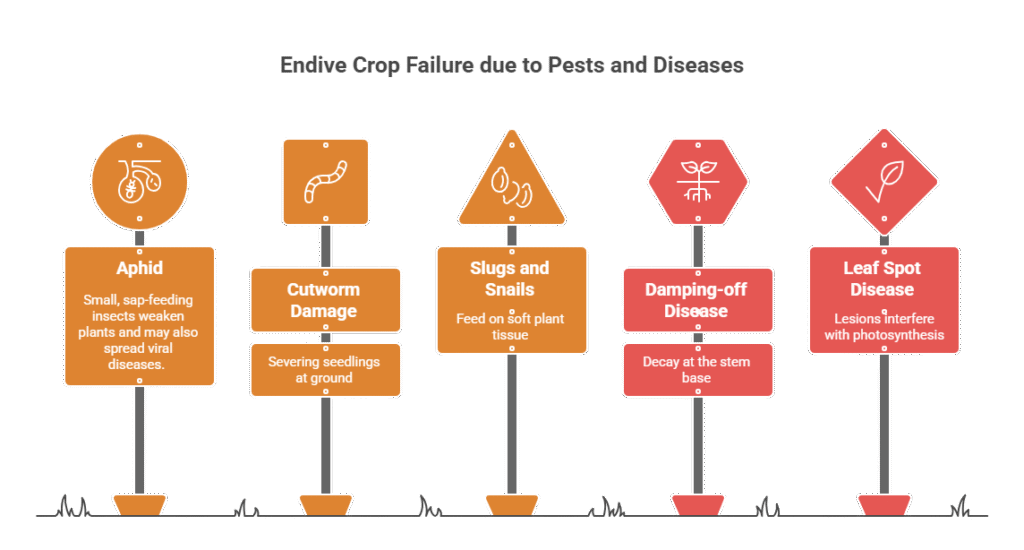
Common Diseases
Damping-off
This seedling disease is common in nurseries and results in decay at the stem base, causing young plants to topple. The most effective approach is prevention, achieved by using sterile potting media, ensuring adequate spacing for good airflow, and avoiding excess moisture. Seed treatment with fungicides containing metalaxyl + mancozeb at about 2 g per kg of seed can provide additional protection.
Leaf Spot
These diseases produce small, darkened lesions on the foliage, which interfere with photosynthesis and weaken the crop. Preventive steps include planting certified clean seed, rotating crops, and destroying infected residues. If disease develops, foliar sprays of fungicides such as chlorothalonil (2 g per liter of water) or mancozeb (2–3 g per liter) may be applied every 7–10 days until improvement is seen.
Bottom Rot / Root Rots
Fungal pathogens such as Rhizoctonia attack the roots and basal stem, leading to reduced growth and sometimes plant death. Risk can be minimized by ensuring soils are well-drained, avoiding excessive irrigation, and planting at the correct depth. For chemical management, thiophanate-methyl may be applied as a soil drench (2 g per liter of water) around the plant base, following safety recommendations.
Harvesting
Endive generally requires about 80–90 days from sowing to reach harvest maturity, though this may vary with the cultivar and seasonal conditions. Harvesting is carried out by severing the plant at the base, just below the outermost leaves, using a sharp knife once the head feels firm and well developed.
To preserve quality and extend shelf life, it is best to harvest during the cooler hours of the morning. For plants that have been blanched by tying the outer leaves, the heads should be cut within a few days of blanching to maintain optimal texture and flavor.
Yield
Yields of endive typically range from 10 to 15 metric tons per acre, depending on management and growing conditions. To maintain market quality and extend storage life, harvested heads should be cooled promptly and stored at close to 0 °C under high-humidity conditions.
Cost of Investment per Acre for Endive Farming
| S.N. | Categories | Cost of Investment (NRs.) |
| 1 | Land Preparation | 15,000 |
| 2 | Seed | 2,000 |
| 3 | Nursery Management | 3,000 |
| 4 | Transplanting | 1,500 |
| 5 | Fertilizers and Manure | 8,000 |
| 6 | Irrigation | 5,000 |
| 7 | Weed Control (Pre & Post) | 3,000 |
| 8 | Pest & Disease Control | 3,000 |
| 9 | Harvesting | 4,000 |
| 10 | Miscellaneous Costs | 5,000 |
| Total Cost | 49,500 |
Income per Acre from Endive Farming
| Particulars | Estimated Yield / Acre (Kg) | Market Price (NRs./Kg) | Total Income (NRs.) |
| Yield | 12,000 | 20 | 240,000 |
Analysis of Endive Farming Profit Per Acre
The endive farming venture demonstrates high profitability, with a total investment cost of NRs. 49,500 generating a substantial total revenue of NRs. 240,000.
The net profit, calculated by subtracting the total cost from the total income, amounts to NRs. 190,500. This impressive profitability is further highlighted by the Return on Investment (ROI), a key metric calculated as (Net Profit / Total Cost) x 100%, which yields an exceptional result of approximately 385%.
This means for every Nepalese Rupee invested, the farmer earns a profit of about NRs. 3.85, leading to the conclusion that this is a highly profitable venture per acre.
Crop Calendar for Endive Farming
This calendar outlines the key activities for two primary planting seasons: Spring Planting for a summer harvest and Late Summer Planting for a fall harvest. Timings are approximate and should be adjusted based on local climate conditions.
| Month | Key Activities | Description / Notes |
| January | Planning & Land Preparation | Ideal time for planning the spring crop. Prepare soil by tilling and incorporating well-rotted farmyard manure (15-20 tons/acre) if not done earlier. |
| February | Land Preparation & Nursery Sowing | Finalize land prep. For a spring crop, sow seeds in a protected nursery in late February to get a head start before the last frost. |
| March | Spring Planting: Transplanting | This is the primary month for transplanting seedlings to the main field. Ensure the risk of hard frost has passed. Direct seeding can also begin if soil is workable. |
| April | Early Growth Management | Focus on irrigation, weed control, and pest monitoring (e.g., aphids). Apply top-dressing of nitrogen fertilizer 3-4 weeks after transplanting. |
| May | Vegetative Growth & Care | Continue consistent irrigation (preferably drip). Monitor for pests and diseases like leaf spot. Hoeing and weeding are critical. |
| June | Spring Crop: Harvesting | The spring-planted endive is ready for harvest (approx. 80-90 days after sowing). Harvest in the cool morning hours. |
| July | Land Prep for Fall Crop | After the spring harvest, prepare the land again for the late summer/fall crop. Solarization can help reduce soil-borne diseases. |
| August | Fall Planting: Sowing/Transplanting | The main planting season for the fall crop. Sow seeds directly or transplant seedlings in mid-to-late August for a harvest after the heat subsides. |
| September | Growth Management | Manage irrigation as temperatures begin to drop. Continue weed and pest control. Top-dressing may be applied if needed. |
| October | Blanching & Pre-Harvest Care | As heads develop, begin blanching 1-2 weeks before harvest to reduce bitterness. Monitor for slugs/snails in cooler, damp weather. |
| November | Fall Crop: Harvesting | Primary harvest period for the fall crop. Cooler temperatures often improve flavor. Harvest before hard freezes. |
| December | Post-Harvest & Storage | Market the harvest. Properly store remaining yield at near 0°C with high humidity. Plan for the next cycle and review the season’s results. |
Also Read: Lettuce Farming Profit Per Acre
Sources
Food and Agriculture Organization (FAO)
University of California Agriculture & Natural Resources (UC ANR)
European Plant Protection Organization (EPPO)
Punjab Agricultural University (PAU)
Tamil Nadu Agriculture University (TNAU) – Agritech portal
Indian Council of Agricultural Research (ICAR)
Nepal Agricultural Research Council (NARC)
U.S. Department of Agriculture (USDA).
Ministry of Agriculture and Livestock Development (Nepal)
Disclaimer: This crop farming profits assume optimal conditions. Actual results may vary depending on climate, market prices, and farm management practices.
